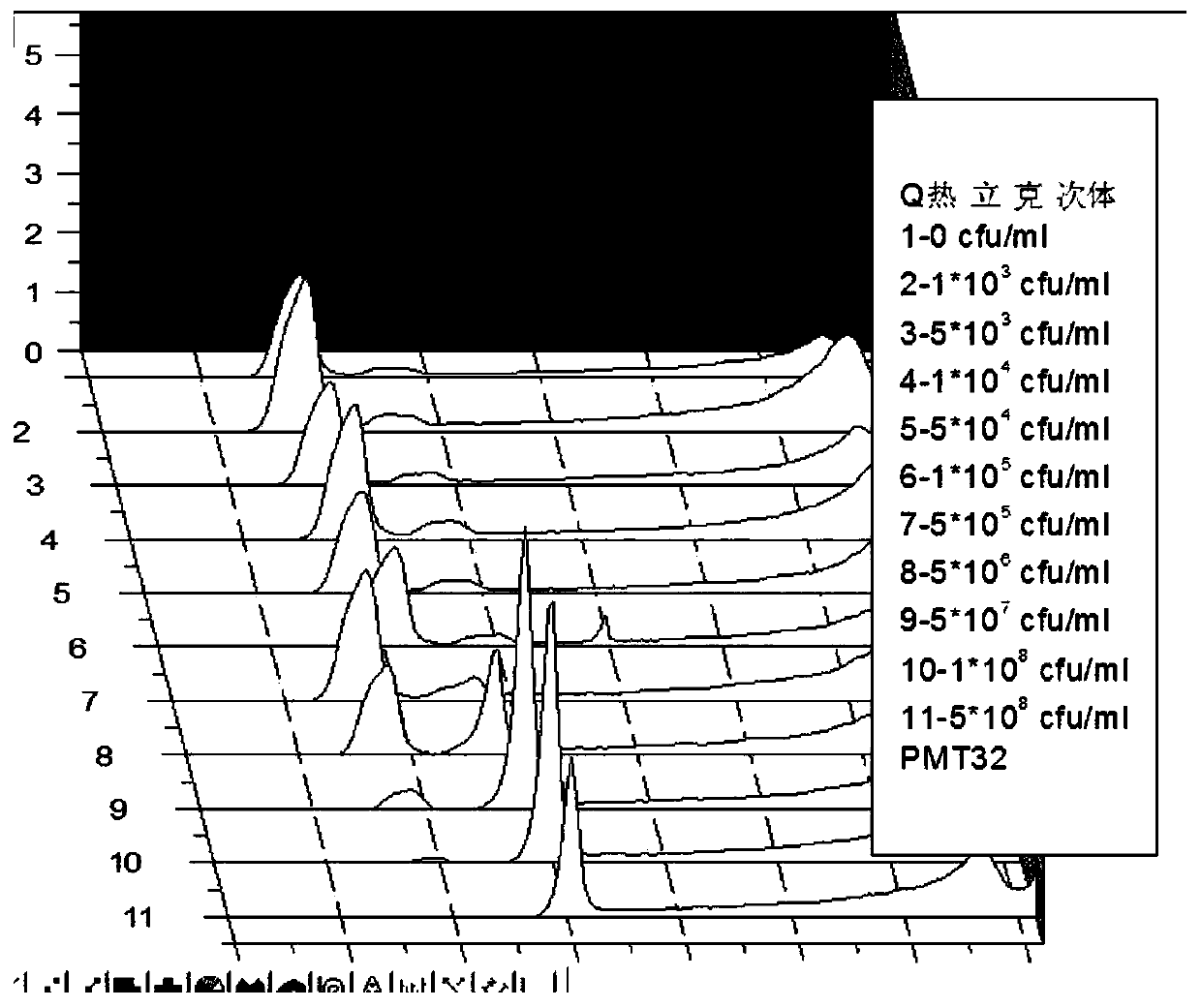Monoclonal antibody composition for quantitative detection of Coxiella burnetii I-phase strains
A technology of Coxiella basilica and composition, which is applied in the field of monoclonal antibody composition, can solve problems such as time-consuming and labor-intensive operation, difficulty in separating pathogens, complicated result judgment and infection risk assessment, etc. The result is a stable effect
- Summary
- Abstract
- Description
- Claims
- Application Information
AI Technical Summary
Problems solved by technology
Method used
Image
Examples
Embodiment 1
[0045] Embodiment 1, preparation of anti-Cox body monoclonal antibody
[0046] 1) Immunization of mice
[0047] Using the inactivated antigen of whole bacterium of Coxiella spp. Xinqiao strain as the immunogen, female 8-week-old BALB / c mice were immunized by subcutaneous injection, and spleen lymphocytes were obtained for hybridoma fusion experiments.
[0048] Purified inactivated Coxiella beinii whole antigen was diluted with PBS pH 7.4. Five 8-week-old female BALB / c mice with similar body weight were selected. For the first immunization, 20 μg of the whole bacterial antigen was emulsified and mixed with 100 μl of Freund’s complete adjuvant and injected subcutaneously; the second subcutaneous immunization and the third subcutaneous immunization were performed every two weeks, and the adjuvant was changed to Freund’s for the second and third immunizations. Incomplete adjuvant; booster immunization was carried out 3 days before fusion, without adjuvant, intraperitoneal inject...
Embodiment 2
[0080] Embodiment 2. Specific detection (ELISA method) of anti-Cox body monoclonal antibody
[0081] Rickettsia spotted heat (Th1 epitope peptides induce protective immunity against Rickettsia rickettsii infection in C3H / HeN mice. Wang P, Xiong X, JiaoJ, Yang X, Jiang Y, Wen B, Gong W. Vaccine. 2017Dec 18; 35( 51):7204-7212), Escherichia coli, Salmonella type 5, Listeria, Brucella, Bacillus anthracis, and Legionella were preserved or cultured in this laboratory, see literature (Zhao Y, Wang H, Zhang P, Sun C, Wang X, Wang X, Yang R, Wang C, Zhou L. 2016. Rapid multiplex detection of 10foodborne pathogens with an up-converting phosphortechnology-based 10-channel lateral flow assay. Scientific reports 6:21342; HaoM, Zhang P, Li B, Liu X, Zhao Y, Tan H, Sun C, Wang X, Wang X, Qiu H, Wang D, Diao B, Jing H, Yang R, Kan B, Zhou L. 2017. Development and evaluation of an up -converting phosphor technology-based lateral flow assay for the rapid,simultaneous detection of Vibrio choler...
Embodiment 3
[0085] Example 3. Sensitivity detection (ELISA method) of anti-Cox coxella monoclonal antibody
[0086] Dilute the inactivated Coxiella beinerii whole bacterial antigen to 2x10 9 For copy number / ml, add 100 μl / well to the ELISA plate, each of 6 duplicate wells, coat overnight at 4°C, wash with PBST for 5 min×5 times, and pat the liquid in the wells clean. Add blocking solution at 200 μl / well and incubate at 37°C for 2 hours, wash with PBST for 5 minutes×5 times, and clean the liquid in the well. Take the monoclonal antibody (mAb 10) for doubling dilution from 250 μg / ml, add 100 μl / well, act at 37°C for 1 hour, wash 5 minutes×5 times; add 0.1% PBST to 100 μl / well to dilute the spicy Root peroxidase (HRP)-labeled goat anti-mouse antibody, incubated at 37°C for 1 hour, washed with PBST for 5 minutes×5 times; added TMB substrate chromogenic solution at 100 μl / well, reacted at room temperature for 15 minutes in the dark; added at 50 μl / well Observe the results of the stop solutio...
PUM
 Login to View More
Login to View More Abstract
Description
Claims
Application Information
 Login to View More
Login to View More - R&D
- Intellectual Property
- Life Sciences
- Materials
- Tech Scout
- Unparalleled Data Quality
- Higher Quality Content
- 60% Fewer Hallucinations
Browse by: Latest US Patents, China's latest patents, Technical Efficacy Thesaurus, Application Domain, Technology Topic, Popular Technical Reports.
© 2025 PatSnap. All rights reserved.Legal|Privacy policy|Modern Slavery Act Transparency Statement|Sitemap|About US| Contact US: help@patsnap.com



